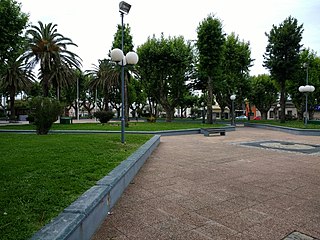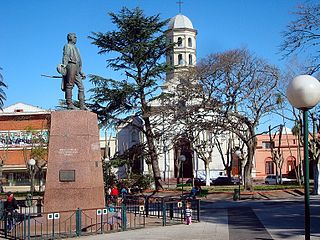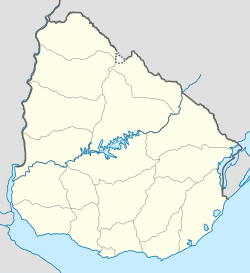
Canelones is the capital of the department of Canelones in Uruguay. Its name is derived from a species of cinnamon, which is called "canelón", growing along the banks of the homonymous river. Since 2010, the city is also the seat of the municipality of Canelones.

Melo is the capital city of the Cerro Largo Department of north-eastern Uruguay. As of the census of 2011, it is the ninth most populated city of the country.

Florida is the capital of Florida Department of Uruguay. Having a population of over 33,000, it is home to almost half of the inhabitants of the department.

San Carlos is a city in the Maldonado Department of southern Uruguay. "San Carlos" is also the name of the municipality to which the city belongs. The municipality includes the following zones: San Carlos, El Tesoro, La Barra, Edén Rock, El Chorro, Manantiales, Balneario Buenos Aires, Punta Piedras, Santa Mónica, San Vicente, El Edén, Paso de la Cantera, Las Cañas, Carapé, Mataojo, Guardia Vieja, Pago de la Paja, Partido Norte, Partido Oeste, Cañada Bellaca, Corte de la Leña, Punta del Campanera, Puntas de Mataojo, and Laguna José Ignacio.

Colón Sudeste–Abayubá is a composite barrio of Montevideo, Uruguay.

Pando is a city in the Canelones Department of Uruguay. It is an important commercial and industrial centre which has become part of the wider Montevideo metropolitan area.
Toledo is a small city in the Canelones Department of Uruguay. Together with Villa Crespo y San Andrés, it forms a population centre of more than 14,000, which is also generally known as "Toledo", although the censual area of Toledo itself has only about 4,400 inhabitants, according to the 2011 census. They are both part of the wider metropitan area of Montevideo.
Progreso is a city in the Canelones Department of southern Uruguay.

San Ramón is a small city in the north of Canelones Department, in southern Uruguay.

Joaquín Suárez is a village in the Canelones Department of southern Uruguay. It is at the intersection of Routes 84 and 74, northeast of Toledo and southwest of Pando. Sauce is about 10 kilometres (6.2 mi) to the north. The villages are all considered parts of the wider metropolitan area of Montevideo.

Empalme Olmos is a village in the Canelones Department of southern Uruguay.

Cerrillos or Los Cerrillos is a very small city in the west part of the Canelones Department of southern Uruguay.
San Bautista is a small city in the Canelones Department of southern Uruguay.

San Jacinto is a small city in the Canelones Department of southern Uruguay, and is also the name of the municipality to which the city belongs.
Sauce is a small city and municipality in the Canelones Department of southern Uruguay.
Libertad is a small city in the San José Department of southern Uruguay. Its main commercial street is 25 de Agosto and its central square is Plaza Treinta y Tres Orientales.
Paso de Carrasco or Paso Carrasco is a city in the Canelones Department of Uruguay.

The Church of Saint Anthony and Saint Clare is a Roman Catholic parish church in Montevideo, Uruguay.
Arroyo de las Piedras is a river in Uruguay.


















